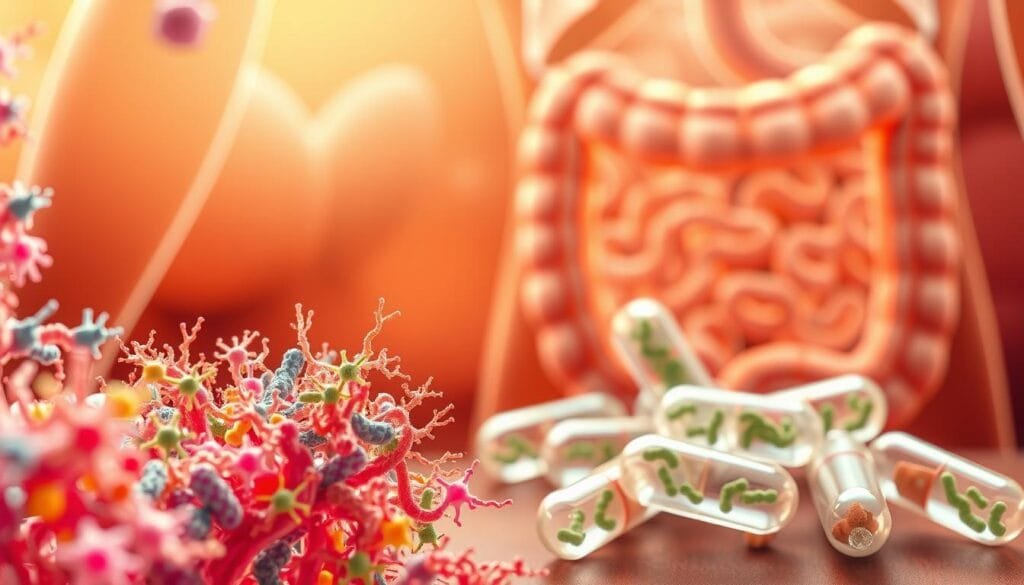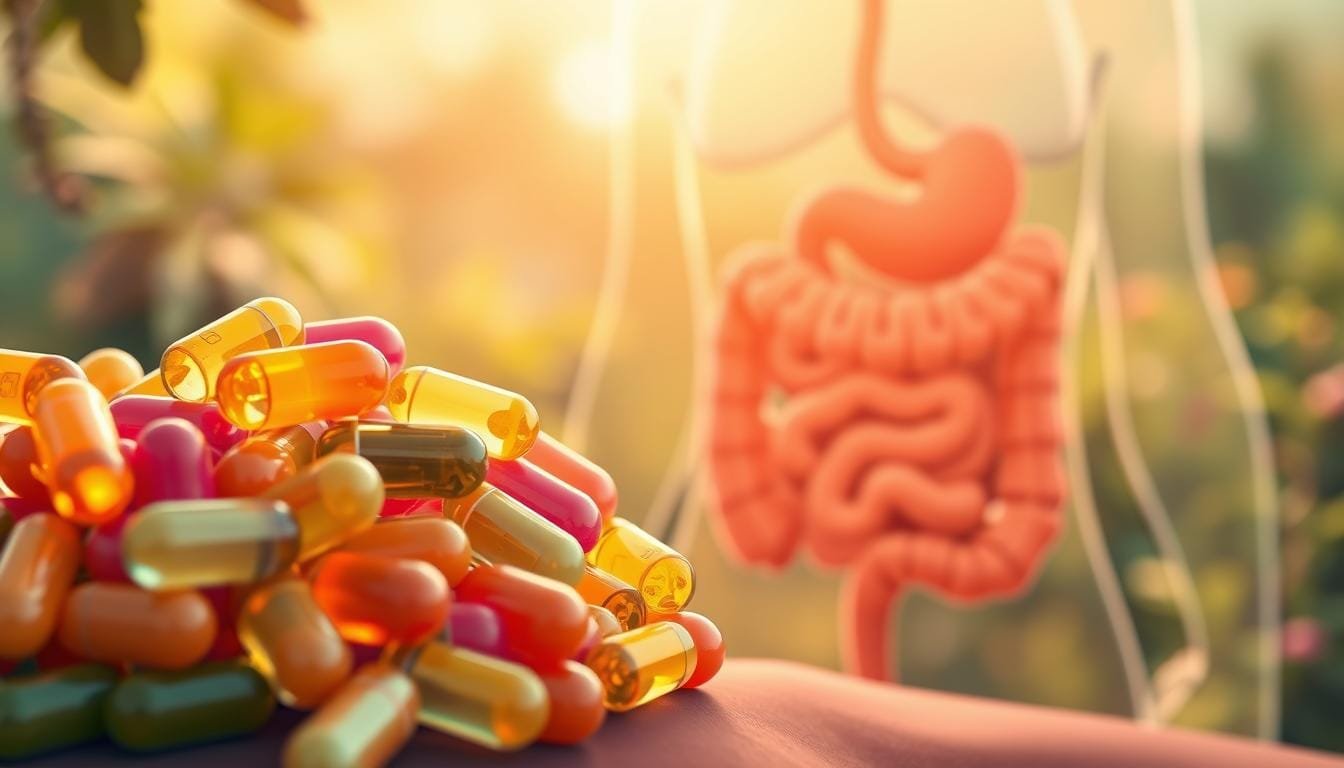Currently Empty: RM0.00
Starting a probiotic regimen can feel like welcoming new friends into your body’s ecosystem. These beneficial microorganisms support digestive health and overall wellness, but like any change, there’s an adjustment period. For most people, this transition is smooth. However, some might notice mild, temporary reactions as their gut adapts.
Bloating or gas occasionally occurs during the first few days, especially with bacteria-based formulas. Yeast-based options might lead to different responses, like thirst or irregularity. These effects typically fade as the body finds its balance. Every person’s microbiome is unique, so individual experiences vary widely.
Wellness Concept, a trusted resource for probiotic supplements for gas relief, emphasizes quality products and personalized guidance. Their team helps users navigate this journey confidently, minimizing discomfort while maximizing benefits.
Key Takeaways
- Mild reactions like bloating are common but temporary
- Responses differ between bacteria and yeast-based formulas
- Individual gut diversity affects adjustment experiences
- Quality supplements reduce transition discomfort
- Professional guidance optimizes probiotic benefits
Overview of Probiotics and Their Health Benefits
Your gut houses trillions of microorganisms that form a dynamic ecosystem. Probiotics are live bacteria and yeasts that strengthen this community when consumed through fermented foods or dietary supplements. These microbes naturally occur in the digestive tract, working to crowd out harmful organisms while aiding nutrient absorption.

What Are Probiotics?
Common strains like Lactobacillus plantarum and Bifidobacterium infantis act as frontline defenders. They produce enzymes that break down food and create compounds supporting gut health. Some formulas include Saccharomyces boulardii, a beneficial yeast that combats diarrhea. Wellness Concept experts recommend matching strains to individual needs, as “each microbiome responds differently to microbial reinforcements.”
Key Health Benefits and Uses
Research shows these microorganisms:
- Reduce bloating in irritable bowel syndrome
- Shorten antibiotic-related digestive issues by 42%*
- Enhance immune system responses to pathogens
| Source | Examples | Key Benefits |
|---|---|---|
| Foods | Yogurt, Kimchi | Daily maintenance |
| Supplements | Multi-strain capsules | Targeted support |
*A 2023 study in Gut Health Journal found specific strains cut antibiotic recovery time. For personalized strategies, Wellness Concept’s team analyzes lifestyle and dietary patterns to optimize results.
symptoms after taking probiotics
Many individuals notice their body responding uniquely during the initial days of microbial support. These reactions often signal the gut adapting to new bacterial colonies or yeast strains. While most adjustments are mild, understanding common patterns helps users navigate this phase confidently.

Digestive Responses: Temporary Turbulence
Bacteria-rich formulas frequently cause gassiness or abdominal swelling in the first week. This occurs as beneficial microbes interact with existing gut flora. Yeast-based options, like those containing Saccharomyces boulardii, might lead to firmer stools or thirst due to their moisture-regulating effects.
Bowel rhythm changes—whether looser or less frequent movements—typically stabilize within 14 days. A 2023 survey showed 68% of users reported normalization by day 10. Wellness Concept advisors suggest tracking patterns using their Gut Harmony Journal for clearer insights.
Beyond the Gut: Whole-Body Signals
Some people notice subtle skin changes or muscle discomfort during adaptation. These occur as microbial metabolites influence various systems. A balanced approach includes:
- Gradually increasing dosage
- Staying hydrated (especially in Malaysia’s tropical climate)
- Pairing supplements with fiber-rich foods
| Type | Common Reactions | Duration |
|---|---|---|
| Bacteria-Based | Gas, mild swelling | 3-7 days |
| Yeast-Based | Thirst, slower digestion | 5-10 days |
“These temporary effects show your ecosystem is recalibrating,” explains Wellness Concept’s nutrition team. They recommend consulting experts if reactions persist beyond two weeks or intensify suddenly.
Digestive Reactions and What They Mean
Your digestive system works like a busy marketplace where new vendors (probiotic bacteria) need time to set up shop. When introducing microbial reinforcements, temporary shifts occur as your gut microbiome reshapes its community. These changes often spark harmless chemical reactions that explain common adjustments.
Temporary Adjustments in Gut Flora
New bacterial strains interact with existing residents in your digestive tract, creating gas as they break down food particles. This process releases short-chain fatty acids—key nutrients that strengthen gut lining. Most side effects peak within 3-5 days as populations stabilize.
Normalizing Digestive Motions Over Time
Bowel patterns often shift before settling into a new rhythm. Research shows 74% of users experience regularity within 14 days. The table below outlines typical timelines:
| Symptom | Typical Duration | Notes |
|---|---|---|
| Bloating | 4-9 days | More common with lactobacillus strains |
| Gas | 2-7 days | Reduces as enzyme production increases |
| Irregularity | 5-12 days | Yeast-based formulas take longer |
Wellness Concept’s nutrition team notes: “These timelines reflect averages—your unique microbiome might need more or less time.” Contact their experts if reactions persist beyond three weeks or disrupt daily life.
Uncovering the Causes of Probiotic Side Effects
Understanding why reactions occur helps users make informed choices. While most adjustments are harmless, specific triggers explain why some people experience stronger responses.
Histamine Production and Sensitivities
Certain probiotic strains naturally create histamine in the digestive tract. This compound regulates immune responses but may cause headaches or skin irritation in sensitive individuals. Key histamine-producing bacteria include:
- Lactobacillus buchneri
- Streptococcus thermophilus
- Lactobacillus helveticus
Fermented foods like kimchi and sauerkraut contain biogenic amines that stimulate the nervous system. Those with histamine intolerance might notice reactions within hours of consumption.
Allergic Reactions and Ingredient Intolerances
Supplements contain additional components that may trigger responses. Common culprits include dairy-based cultures or prebiotic fibers like inulin. The table below shows frequent triggers:
| Component | Potential Reaction | Alternatives |
|---|---|---|
| Lactose | Bloating, discomfort | Dairy-free formulas |
| Soy | Skin irritation | Plant-based capsules |
| Prebiotics | Gas, cramping | Fiber-free options |
Wellness Concept advisors recommend: “Check labels for allergens and start with low-histamine strains if sensitive.” Their team helps identify suitable options based on dietary needs and health history.
Strategies for Managing Probiotic Side Effects
Adjusting to microbial reinforcements resembles acclimating to a new climate—it requires smart strategies. Start with small doses to let your gut microbiome adapt gradually. Many find taking supplements with meals reduces temporary reactions, as food buffers interactions.
Hydration plays a starring role in Malaysia’s tropical heat. Water helps flush excess gases and supports smoother transitions. Those using yeast-based formulas might need extra fluids to balance moisture levels naturally.
Strain selection matters. Lactobacillus rhamnosus often suits sensitive systems better than histamine-producing varieties. Wellness Concept’s team uses microbiome assessments to match users with compatible blends, minimizing adjustment periods.
Track changes in a simple journal—note timing, diet, and bodily signals. This reveals patterns and helps identify triggers. If reactions linger beyond three weeks, consult experts to explore alternatives like low-FODMAP formulas or fermented foods.
Patience remains key. As microbial balance stabilizes, most temporary effects fade. Wellness Concept offers free consultations to refine approaches, ensuring gut harmony becomes second nature.
FAQ
What are common reactions when starting probiotics?
Some people experience mild digestive discomfort, like gas or bloating, as their gut microbiome adjusts. These effects often subside within a few days as the body adapts.
How do probiotics support gut health?
Probiotic supplements introduce beneficial bacteria to the digestive tract, which may improve digestion, strengthen the immune system, and help balance intestinal flora. Fermented foods like sauerkraut also provide natural sources.
Can probiotics cause allergic reactions?
Rarely, certain strains or ingredients in supplements—such as dairy or soy—might trigger sensitivities. Always check labels and consult a healthcare provider if rashes, swelling, or breathing issues occur.
Why do some people feel worse before feeling better?
Temporary adjustments in gut flora can lead to short-term side effects. For example, histamine-producing strains might temporarily worsen symptoms in sensitive individuals until the body adapts.
How long do probiotic side effects typically last?
Most mild reactions resolve within 1–2 weeks. If discomfort persists, lowering the dose or switching strains—like opting for low-histamine options—may help.
Are there risks linked to specific probiotic strains?
Certain yeasts or bacteria in supplements might not suit everyone. For instance, individuals with small intestinal bacterial overgrowth (SIBO) should consult a doctor before use to avoid worsening symptoms.
Can probiotics interact with medications?
While generally safe, some supplements might affect antibiotic efficacy or immune responses. Discuss with a healthcare provider if taking immunosuppressants or undergoing treatment for infections.
What’s the best way to reduce discomfort when starting probiotics?
Begin with a low dose, pair with fiber-rich foods, and stay hydrated. Gradually increasing intake allows the digestive tract to adjust more smoothly.


